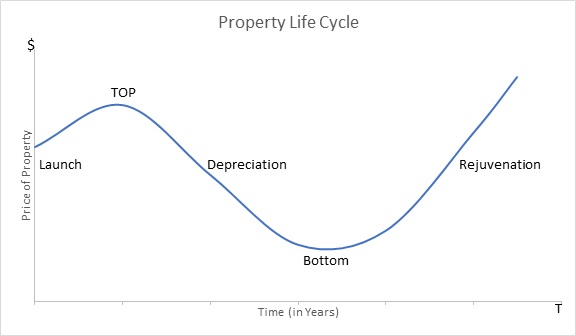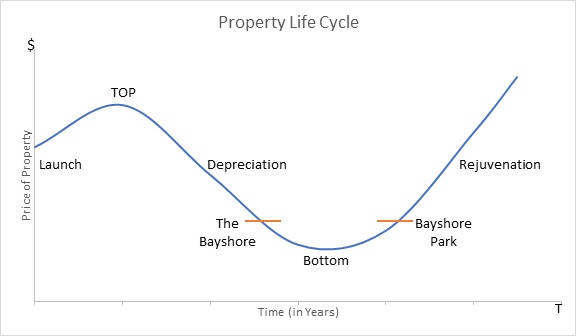Properties have life cycles, just like us. We know that property prices are largely driven by demand and supply. Today as we examine the correlation between the price and age of a property, we exclude external influences like demand, supply, inflation, immigration policies, infrastructure changes, etc.
Let’s look at the profile of a typical 99-year leasehold or freehold condominium since it forms the majority of private residential properties in Singapore.
The launch – forming of a property
After land is acquired and architecture plans are drawn, a developer will launch the property for sale. At this stage, prospective buyers do not get to see a finished product. Instead, they purchase the property based on drawings, plans, and probably a nice model of how the development looks like.
The purchaser then takes up a mortgage on the property, servicing instalments as the developer calls for progressive payments. Since the property is not completed, there is no rental income.
You imagine and anxiously wait for the finished product.
The birth – Temporary Occupation Permit
After years of crossed fingers and eager anticipation, you finally get to see the finished product. We usually see a price increase (about 10 to 20 percent) between the launch and the Temporary Occupation Permit (TOP) because:
– There is no risk of the developer going bust and property not completing
– What you see is what you get – bask in the full glory of the physical product
– Instant gratification – you can use the property right away, or rent it out for income
However, I must point out that this is not the time where rental value is the highest – because there are a few hundred units within the same development that, like yours, are waiting anxiously to get rented.
The aging – depreciation
Just like humans, properties age too. Cracks start forming on the walls, and facilities start to look worn and dated. While a resort-themed pool was all the rage 15 years ago, tenants and homeowners now prefer cantilevered infinity pools perched on rooftops. Tastes change; what was fashionable before now gets phased out by newer, more functional / efficient replacements.
Rentals decline as tenants look out for newer developments, resulting in price declines on the property.
The bottom – cessation of depreciation
Land does not depreciate. At least for all freehold land and leasehold land which the government will allow a top-up on the lease.
The rejuvenation – redevelopment
We know Singapore has limited land. However, Singapore has less of a limitation on airspace much like Hong Kong and many other cities around the world. The Urban Redevelopment Authority (URA) manages the Master Plan which governs land usage in Singapore.
Plot ratio is the magical number to determine the intensity of the land usage, or how much of floor area can be built within a plot of land.
As land gets used up in Singapore, the authorities will start putting higher numbers to the plot ratio, intensifying land use – of course, first ensuring the infrastructure (roads and transportation) and amenities (shops and schools) can support a denser population.
So, this results in many of the en-blocs (also known as collective sales) we are seeing today – a more efficient use of land.
Because of a higher plot ratio, developers can now build more units on a given plot of land. Hence, the depreciated piece of land your property is sitting on now suddenly becomes more valuable. As new properties are sold for higher prices, the land your property is sitting on also appreciates.
Case study: The Bayshore vs. Bayshore Park
Both developments are in District 16, right next to each other.
A check on the units from each of these developments would bring about similar results – an average asking price of about $800 to $1,000 psf.
When you look at the age of each development, Bayshore Park received its TOP in 1986, about 31 years ago. On the other hand, The Bayshore received its TOP in 1999, which means its age is currently about 18 years.
Both developments have a 99-year lease.
Astute investors know that The Bayshore has maximised its gross floor area (GFA), according to its plot ratio, while Bayshore Park has more room towards its maximum allowable GFA.
Based on the property life cycle, The Bayshore at 19 years since its TOP, is currently in the depreciation phase. It’s still set to depreciate further, and may only bottom out when the URA decides to increase the density of residents on the piece of land by tweaking its plot ratio.
Conversely, Bayshore Park has already been through its depreciation phase and even past the bottom of the life cycle. It’s currently working its way back up the rejuvenation stage, where there is more potential for redevelopment.
A property purchase can be an emotional process. Many a time, we choose to follow our hearts. The newer property may look more attractive, but we should look beyond face value and do our research to seek out options that will bring us the best returns on our investment.
This article was first published on PropertyGuru on June 23 2017.
Want to find the best mortgage rate in town? Check out our free comparison service to learn more!
Read more of our posts below!



